Petunia is a perennial herbaceous plant that has gained popularity thanks to its beautiful, delicate, and large inflorescences. During flowering, there are so many blooms that the bush is practically hidden beneath them. While adult petunias are low-maintenance, their seedlings require extra attention.
Petunias are grown not only in gardens but also as houseplants. With proper care, they can bloom even in an apartment or on a balcony. Learn how to grow petunias indoors from ready-made seedlings or seeds and how to care for them below.
Table of contents
Growing Petunias Indoors: Key Considerations
Can petunias be grown at home? Yes, absolutely—but to ensure flowering, optimal conditions must be provided.
Growing petunias indoors is considered more challenging than in a garden. This is because the plant is light-demanding. In autumn and winter, artificial lighting will be necessary.
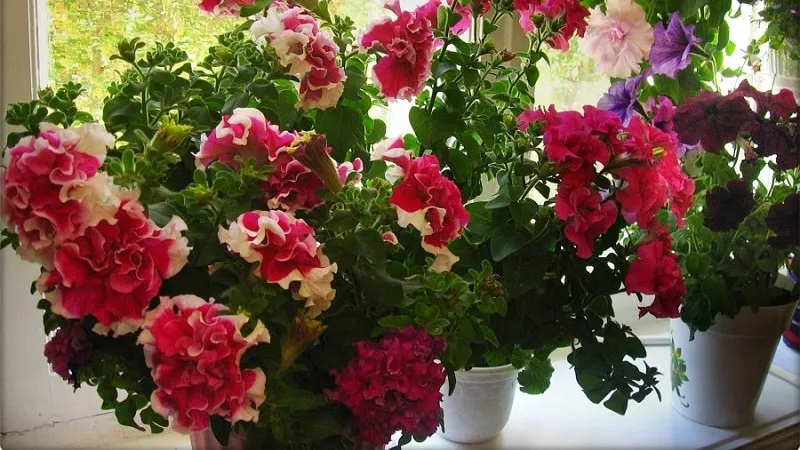
Additionally, the plant cannot tolerate waterlogging. It becomes susceptible to disease and may die quickly. This issue is especially common in pots.
At the same time, petunias require high humidity. Dry air can lead to spider mite infestations and powdery mildew.
Indoors, petunias bloom just as beautifully as in open ground, but they cannot produce flowers year-round. The plant enters a dormant phase from mid-November to mid-January or early February. Under optimal conditions, flowering lasts from February to October.
Bush-type petunias are better suited as houseplants. Trailing (hanging) varieties are more suitable for balconies, hanging baskets, and vertical gardens.
Fun fact! Despite being a perennial, petunias are often grown as annuals in outdoor gardens.
Planting Petunias at Home
Petunias can be planted in two ways—from cuttings or seeds. The first method is simpler and yields faster blooms. The second takes more time but results in hardier plants.
Note: Seeds collected from garden-grown flowers may produce blooms of a different color than the parent plant.
Choosing Soil and Containers
When growing petunias indoors, soil preparation is crucial. The soil should be slightly acidic, loose, and nutrient-rich.
Use universal potting mix or specialized flower soil. Adding hydrogel helps retain moisture. You can also prepare your own mix:
- garden soil – 2 parts;
- peat – 2 parts;
- compost – 1 part.
To every 10 liters of this mix, add 1 cup of wood ash, 1 tbsp of superphosphate, and 2 tsp of potassium sulfate. Mix thoroughly. Disinfect the soil by baking it in the oven, watering it with a dark pink potassium permanganate solution, or treating it with a mix of 1 tbsp copper sulfate and 5 liters of water.
Proper drainage is essential for petunias. Use glass beads, broken ceramics, crushed brick, expanded clay, small gravel, or seashells. Disinfect the drainage as you would the soil.
Container choice depends on the planting method. Cuttings root best in individual cups. Seeds are usually sown in a shared tray.
For cuttings, disposable cups or small pots (250–400 ml) work well. Seedlings grown from seeds are later transplanted into similar containers.
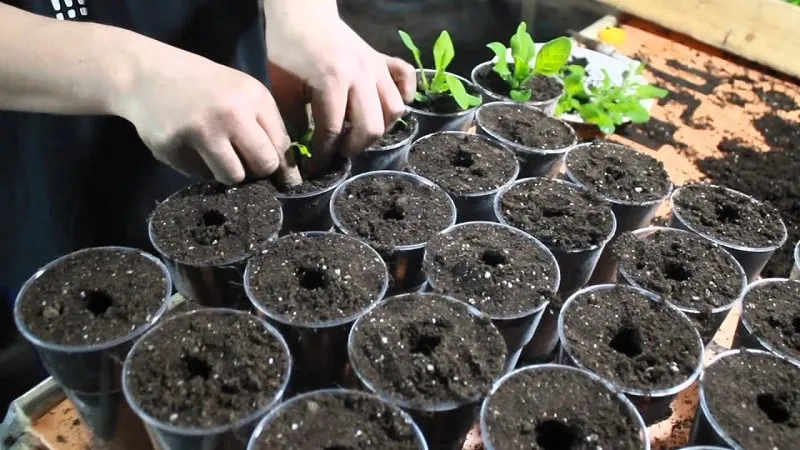
Seeds are sown in a shared container—either seedling trays or repurposed materials (cake boxes, noodle containers, cut bottles, etc.).
One adult bush petunia needs a 3-liter pot. Some growers prefer planting multiple plants in one large pot (e.g., three in a 10-liter container) to maintain optimal soil moisture and microclimate.
Important: Pots must have drainage holes.
Disinfect containers by soaking them in a dark pink potassium permanganate solution for 30 minutes or pouring boiling water over them.
Peat pellets are a convenient option. Each seed is planted in its own pellet, eliminating the need for repotting. Seedlings can be transplanted directly in their peat casing.
Peat pellets don’t require disinfection. Place them hole-side down in a deep container, pour boiling water over them, and add more water as needed. Once expanded, flip them hole-side up and use.
Growing from Seeds
Purchase petunia seeds from a garden center or supermarket. If they are pre-treated and coated (as indicated on the package), they’re ready to plant.
For untreated or self-collected seeds, prepare them as follows:
- Sorting. Remove debris and damaged seeds. Soak in salted water for 30–60 minutes—floating seeds won’t germinate.
- Disinfection. Soak in a light pink potassium permanganate solution for 30 minutes.
- Growth stimulation. Soak for 12 hours in a growth stimulant (e.g., "Epibrassinolide," "Liquid Fertilizer for Seedlings").
Planting petunia seeds is straightforward:
- Fill a tray with 1 cm of drainage, then add soil. Water with room-temperature, settled water.
- Sprinkle seeds on the surface. Press lightly into the soil without covering them.
- Mist with water. Cover with plastic wrap and place on a windowsill.
Using non-woven fabric as a cover eliminates the need for daily ventilation.
Germination takes about 2 months. Ideal temperature: +25…+26°C. After sprouting, reduce to +20°C (day) and +16°C (night).
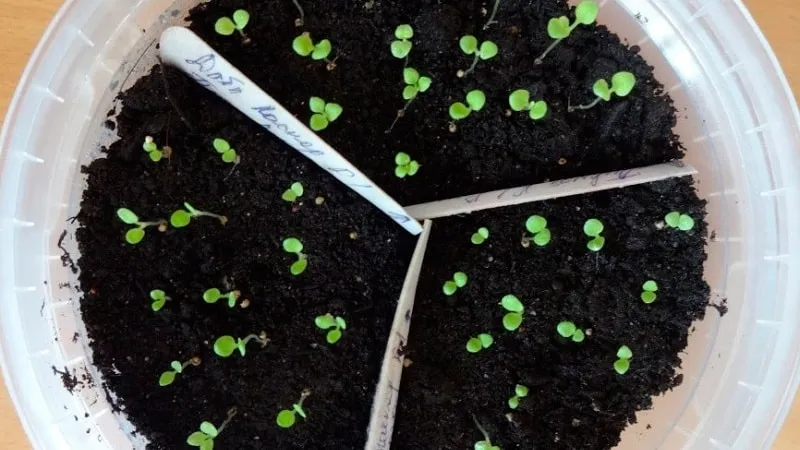
Before germination, mist the soil as needed. Ventilate daily for 10–15 minutes.
Once seedlings emerge, gradually increase ventilation time before removing the cover. Water only at the base.
Transplant seedlings into individual pots after the second true leaf appears. Water the soil a day before transplanting. Gently lift seedlings with a fork to avoid root damage. Plant them in pots filled with drainage and soil, keeping the root neck at the same level.
Fun fact! Some hybrid petunias don’t require transplanting.
Move to a permanent 2–3-liter pot when roots fill the starter container.
Rooting and Planting Cuttings
A faster way to grow petunias is from cuttings. These are sold at nurseries or can be taken from garden plants.
Cut side shoots with at least 2 buds. The parent plant should be healthy, without spots or disease signs.
Avoid watering the parent plant for 2–3 days before taking cuttings—this improves rooting success.
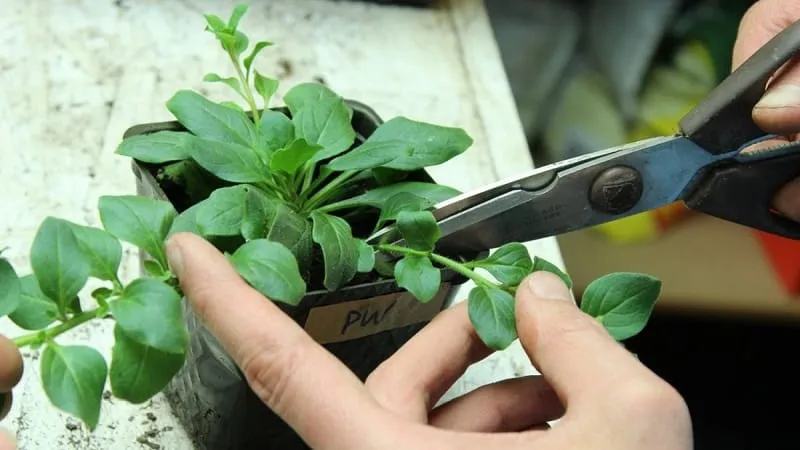
Before planting, soak cuttings for 30 minutes in a light pink potassium permanganate solution, then 5–6 hours in a rooting stimulant (e.g., "Indole-3-butyric acid"). Fill cups with 1 cm of drainage and soil. Water with room-temperature, settled water.
Remove lower leaves to prevent rot. Insert the cutting deep enough to stand upright. Cover with a bag or plastic cup.
Ventilate cuttings daily for 20–30 minutes. Water at the base as needed.
After 2 weeks, increase ventilation time before removing the cover. Transplant into individual pots after a month.
Tip: Cuttings can also root in water. Place them in a glass of room-temperature water (optional: add rooting hormone). Change water regularly to prevent stagnation. New shoots indicate successful rooting.
Plant Care
For year-round indoor growth, provide these optimal conditions:
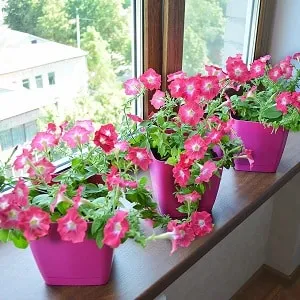 Light. In warm months, no extra light is needed—place on a south/southeast windowsill or balcony. In early spring and late autumn, provide 16 hours of light daily using grow lights (20 cm above plants).
Light. In warm months, no extra light is needed—place on a south/southeast windowsill or balcony. In early spring and late autumn, provide 16 hours of light daily using grow lights (20 cm above plants).- Temperature. Ideal: +20°C. Higher summer temperatures are tolerated.
- Watering. Water at the base with room-temperature, settled water when the soil dries. Avoid wetting leaves. Overwatering causes disease. Water in the morning or evening.
- Fertilizing. Every 2 weeks in spring, summer, and autumn, use a potassium-phosphorus fertilizer (e.g., "Monopotassium phosphate"). Compost tea or wood ash also works.
- Soil aeration. Loosen soil after watering to prevent compaction and waterlogging.
- Pruning. Pinch the central stem above the 4th–6th leaf to encourage bushiness. Repeat if needed. Remove faded flowers.
Consistent care is key. Neglect makes plants prone to diseases and pests like spider mites.
Winter Care for Potted Petunias
Can petunias survive winter indoors? Yes—this is also an easy way to preserve garden plants for next year. After wintering indoors, they can be replanted outside or used for cuttings.
Petunias transplant well. Brought inside before frost, they may bloom until late October.
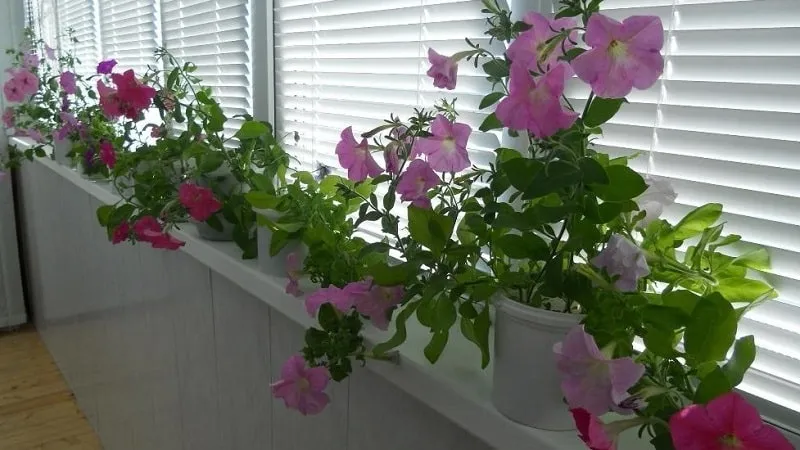
Transplanting Petunias from Garden to Pot
Use garden soil or the seedling mix described earlier. Dig up the plant with its root ball, transfer to a pot, fill gaps with soil (keep the root neck at the same level), water, and bring indoors.
Winter Growing Conditions
In winter, petunias are dormant and require minimal care:
- Temperature: +10…+16°C. They can survive at +2°C (e.g., on a cool windowsill or in a summer kitchen).
- Humidity: High, especially near radiators.
- Watering: Reduce to 1–2 times weekly with room-temperature water. Avoid wetting leaves.
- Fertilizing: None needed.
Provide at least 12 hours of light daily using an LED grow light (20 cm above plants).
Use a humidifier or place water bowls near the plant. A wet cloth on the radiator also helps.
Important: Remove faded flowers after blooming ends.
Conclusion
Petunias thrive in gardens, balconies, and windowsills, offering abundant, long-lasting blooms. As perennials in warm conditions, they flower for up to 9 months.
Indoor care is slightly more demanding than outdoors, requiring attention to temperature, humidity, and light. Overwatering risks in pots must be managed to prevent fungal diseases.







